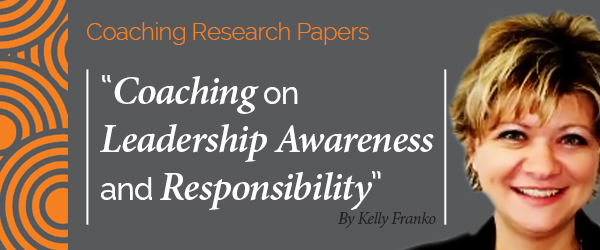 Research Paper By Kelly Franko
Research Paper By Kelly Franko
(Leadership & Business Coach, UNITED STATES)
Coaching Organizations
Today’s leaders face multi-dimensional challenges. Even a locally owned small business feels the impact of the global economy. Generational divides keep leaders busy trying to find ways to meet employee needs. Staying on top of the game requires more self – awareness than ever before as a leader. Gone are the days of managers dictating to employees and shouting out orders. Employees expect and appreciate involvement in business direction and dialogue. Leaving them out of an organization’s vision can create dissonance resulting in a lack of commitment to the organization. It also sets an organization up for frequent turn over which brings with it the high costs involved with onboarding and existing employees as well as those costs associated with background checks and training of new employees.
Shouldering so many responsibilities, leadership can become a daunting task. Energy levels, creativity and personal growth give way to attending to the daily whirlwind of operating. Coaching in the business environment has erupted as a means through which leaders can find the support and growth partner needed to become what they desire to be. Offering an outlet for discussion of goals, challenges, and opportunities, coaching can move leaders and their organizations forward.
Realizing the value that coaching brings to a business, savvy leaders will create a coaching environment through which all managers can aspire. Organizations that seek to develop individuals in leadership positions experience company culture that attracts employees and customers alike. And, company culture can be a great competitive advantage. When seeking a return on investment (ROI), an investment in coaching will not appear on a budget statement in the form of a profit. The ROI will be seen in employee productivity and engagement. These are two areas many businesses struggle to effectively manage. Coaching produces both as an end result, therefore generating revenue and profit for the company.
Organizations and their cultures are immensely diverse. This diversity provides fertile ground for coaching to take root. No two companies will have the same people, mindset, culture, policies, etc. These differences will always allow for different coaches with different methodologies to create different yet positive outcomes for a given organization. While the challenges the company may face will be of a wide variety, many of the same coaching strategies and tools will prove to be successful when implemented in the manner necessary for that particular business.
The size of an organization will also be a variable in the implementation of coaching. Smaller organizations may be able to experience a change more quickly than a larger one since there are not as many levels to get through. However, the commitment to the change will be the bigger determining factor regardless of the organization’s size. If the top leaders of the company demonstrate an unwavering commitment to the change, the ability to garnish support throughout the organization will happen more quickly. When leaders are not committed to a change themselves, this will create fluctuating levels of change in the organization.
Coaching Strategies
The coaching culture is becoming more wide spread and known to many organizations. As business and leadership coaching continues to grow as a niche market, its value gains more awareness throughout the business world. More and more information on the value and benefits of coaching is available every day. Coaching strategies and tools are more readily available and more in tune with the needs of an organization.
There are many factors that many impede a business from succeeding. These factors can be internal or external. As mentioned before, employee performance can be directly linked to the style of leadership they experience. Employees may lose interest and begin to perform at a lower level, thus having a direct impact on company. When business coaching models are introduced and work towards leadership development and improving employee performance begins, an overall improvement in company performance can be seen.
Many coaching models exist today that are able to implemented into a business environment. Several of these models are outlined below.
Traditional coaching models
The Traditional Coaching model focuses on how to do a job and ways to do it better. Many feel that this model is outdated and does not focus on individual strengths and positives. Negative feelings may result due to the assumption that something is currently being done wrong and needs to be fixed.
This model can set an organization up for failure because there is coercion employed by the coach. This discourages members from performing well.